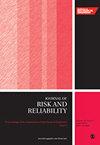Analyze periodic inspection and replacement policy of a shock and wear model with phase-type inter-shock arrival times using roots method
IF 1.8
4区 工程技术
Q3 ENGINEERING, INDUSTRIAL
Proceedings of the Institution of Mechanical Engineers Part O-Journal of Risk and Reliability
Pub Date : 2023-01-28
DOI:10.1177/1748006x221151094
引用次数: 1
Abstract
We consider a shock and wear model in which the inter-shock arrival process is a phase-type (PH) renewal process, and the system’s lifetime is generally distributed. The system has two competing failure modes. One failure mode is due to random shocks, which cause failure by overloading the system. The other failure mode is owning to wear-out failures, which usually happen after the system has run for many cycles. System failure is not self-announcing and remains undiscovered unless an inspection is performed. The intervals between successive inspections are identical and equal to T time units. If a system failure is detected, the corrective repair or replacement is conducted immediately. If the system is found working at inspection, preventive maintenance will be carried out to prolong its useful life. Furthermore, to model the occurrence of events with an underlying monotonic trend, the extended geometric process (EGP) is employed to account for the impact of different types of failures on the system’s degradation. Moreover, for establishing the cost rate function in our model, the counting process generated from a PH renewal shock process is studied in detail using the roots method and formula for calculating residues. Based on these results, the survival function and other characteristics of the system are further investigated. Finally, numerical examples that determine the optimal inspection period T[Formula: see text] and the optimal replacement policy N[Formula: see text], which minimizes the long-run average cost rate, are presented.用根法分析具有相位型间冲击到达时间的冲击磨损模型的定期检查和更换策略
本文考虑了一个冲击磨损模型,该模型中冲击到达过程是一个相型更新过程,系统的寿命是一般分布的。该系统有两种相互竞争的失效模式。一种失效方式是随机冲击,即系统过载导致故障。另一种故障模式是损耗故障,通常发生在系统运行多个周期之后。系统故障不是自行宣布的,除非执行检查,否则不会被发现。连续检查之间的间隔是相同的,等于T个时间单位。如果检测到系统故障,立即进行纠正性修复或更换。如果在检查中发现系统工作,将进行预防性维护以延长其使用寿命。此外,为了模拟具有潜在单调趋势的事件的发生,采用扩展几何过程(EGP)来解释不同类型的故障对系统退化的影响。此外,为了建立模型中的成本率函数,我们使用根法和残差计算公式详细研究了PH更新冲击过程中产生的计数过程。在此基础上,进一步研究了该系统的生存功能和其他特性。最后,给出了确定使长期平均成本率最小的最优检查周期T[公式:见文]和最优替换策略N[公式:见文]的数值算例。
本文章由计算机程序翻译,如有差异,请以英文原文为准。
求助全文
约1分钟内获得全文
求助全文
来源期刊

Proceedings of the Institution of Mechanical Engineers Part O-Journal of Risk and Reliability
ENGINEERING, MULTIDISCIPLINARY-ENGINEERING, INDUSTRIAL
CiteScore
4.50
自引率
19.00%
发文量
81
审稿时长
6-12 weeks
期刊介绍:
The Journal of Risk and Reliability is for researchers and practitioners who are involved in the field of risk analysis and reliability engineering. The remit of the Journal covers concepts, theories, principles, approaches, methods and models for the proper understanding, assessment, characterisation and management of the risk and reliability of engineering systems. The journal welcomes papers which are based on mathematical and probabilistic analysis, simulation and/or optimisation, as well as works highlighting conceptual and managerial issues. Papers that provide perspectives on current practices and methods, and how to improve these, are also welcome
 求助内容:
求助内容: 应助结果提醒方式:
应助结果提醒方式:


